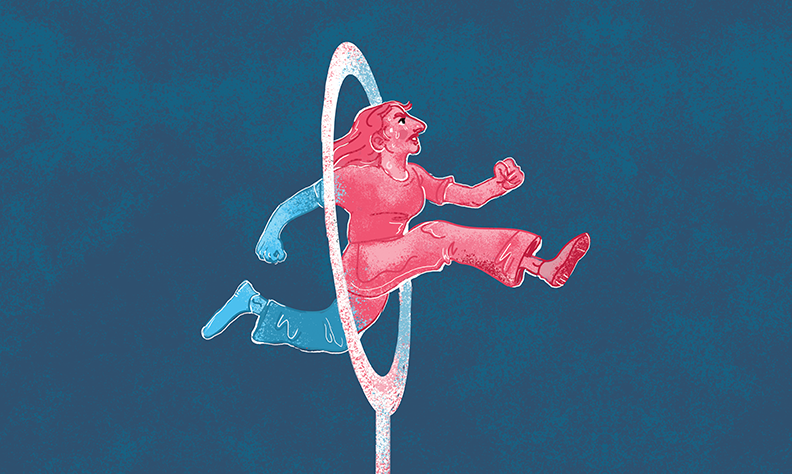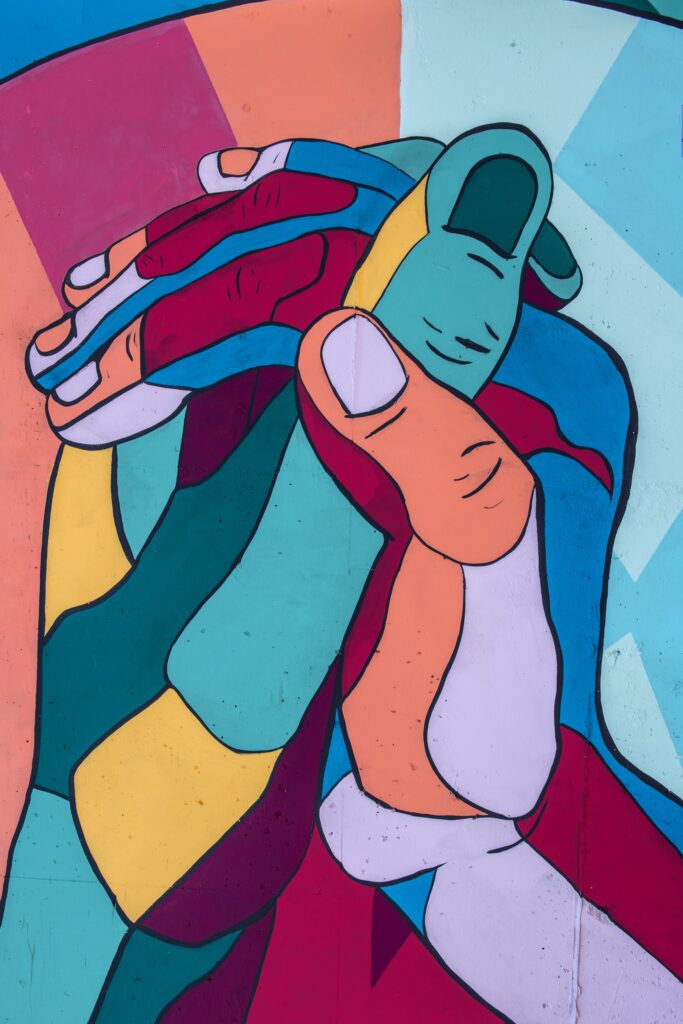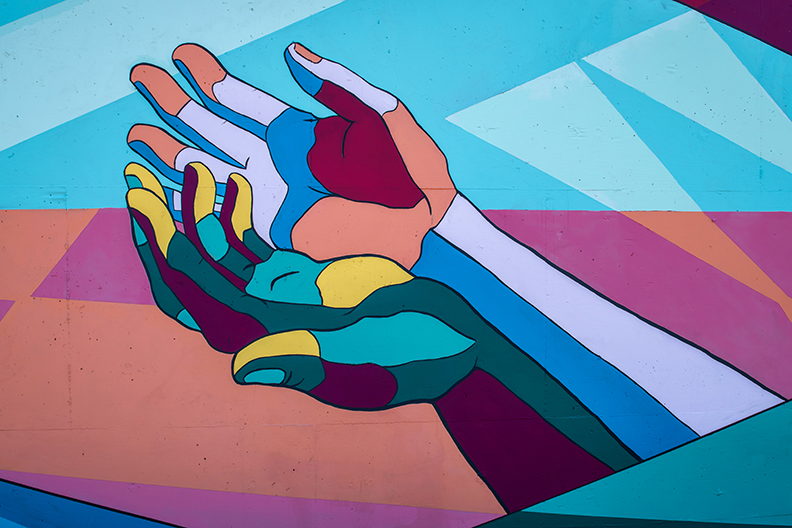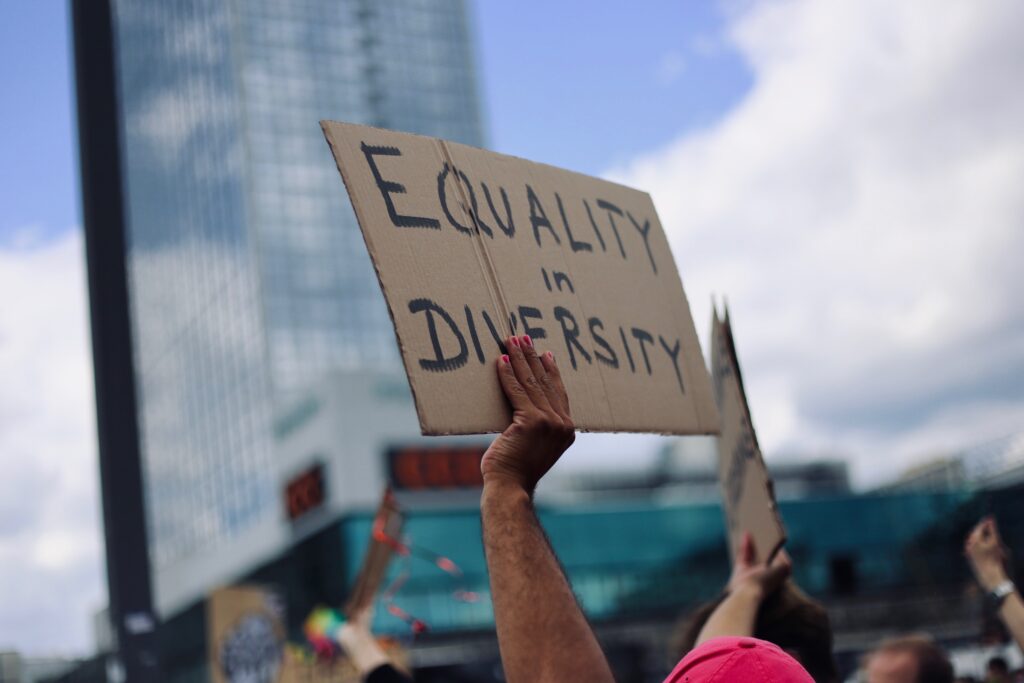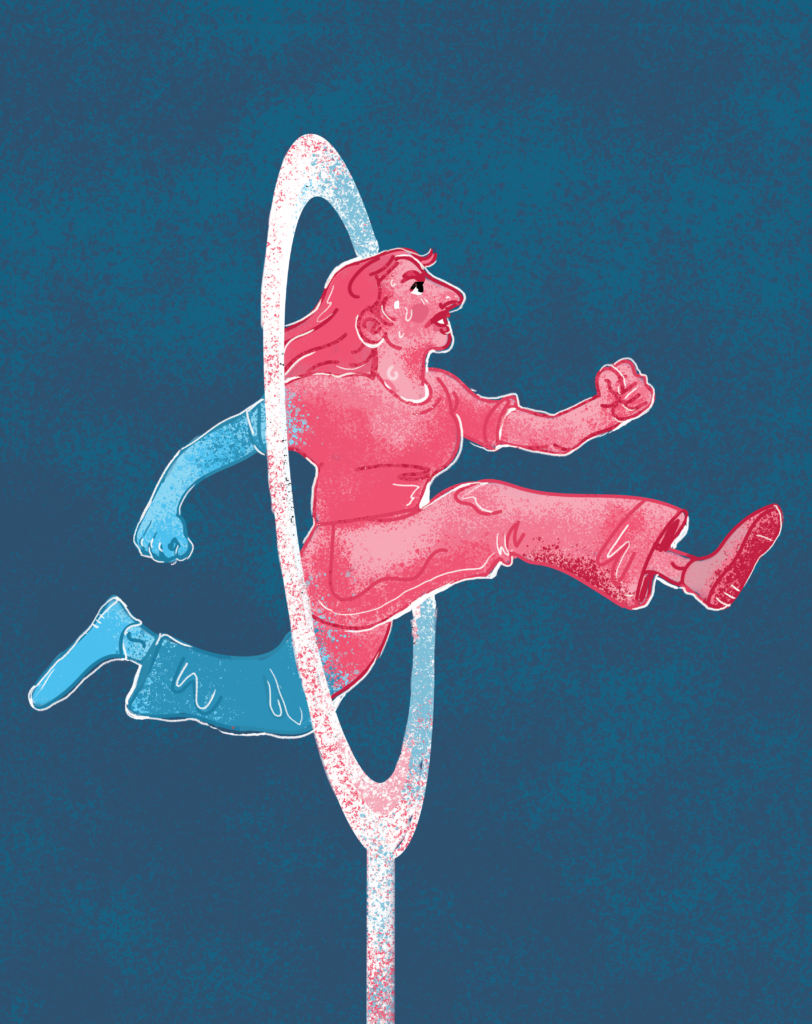Fighting for self-determination in Alaska
Illustration by Ellis Barnett
Brittany Elfrink is in a better place than she was a year ago.
Last summer, she was preparing for gender-reassignment surgery, the culmination of years of discernment about her true self.
Elfrink struggled with gender dysphoria, as many other transgender people do. This condition causes distress and emotional pain in individuals whose gender identity conflicts with the sex that they were assigned at birth. The disconnect between how those individuals feel physically and mentally, and how society regards them, can cause severe anxiety and depression, among other mental health issues.
“You have no idea what someone is going through: depression, anxiety, being disowned by parents, worrying about how the general public thinks of them, dealing with how they have to act to try and fit in,” she said. “It can be even worse for those that are also a member of another minority group. People can go through a lot.”
Elfrink said that she smiles more now and feels full of life. She gets out more and says she feels a lot more centered.
“I don’t do the what-ifs,” she said. “I just turned 40 so I’ve got like a whole life ahead of me and I’m still learning who I am.”
Elfrink suggests taking the time to understand other people without making assumptions. That’s why the current atmosphere surrounding civil rights for transgender individuals is so unsettling for her and others like her.
Progress and setbacks
For the trans community, it had been a decade of considerable progress toward greater public awareness and significant legal victories. But those victories have felt less than certain in the past two years as targeted bills at the state level have been introduced to deprive transgender people of civil rights, adequate physical and mental health care, safety and equal opportunities.
USA Today recently reported that transgender Americans are facing as many as 280 proposals in across the country that would erase many of their freedoms.
This is an increase from 147 proposals in 2021 and 79 in 2020 — the same year that the Supreme Court barred sex discrimination against LGBT individuals on the job and the Trump administration rolled back health care protections for transgender people by removing “sexual orientation” and “gender identity” from the anti-discrimination language.
Mental health at stake
Living in a society that is quick to judge anyone outside “the norm” can be challenging for anyone’s mental health. Research shows that transgender people around the world and in the U.S. are often marginalized and exposed to widespread social stigma, discrimination, exclusion, harassment, and both physical and sexual abuse. Today, they continue to fight for their civil rights, like adequate physical and mental health care, safety, and equal opportunities.
Elfrink almost took her own life twice between the time that she came out publicly in 2019 and the time she was able to undergo gender affirmation surgery at the end of 2021. Today, she said, is the happiest she has ever been and said transitioning has saved her life.
She smiles more now and feels full of life. “I don’t do the what-ifs,” she said. “I just turned 40 so I’ve got like a whole life ahead of me and I’m still learning who I am.”
A study from UCLA Williams Institute estimates that there are approximately 1.4 million trans adults living in the United States.
Before the pandemic, LGBTQ people, particularly transgender and gender non-conforming people, were deeply impacted by housing insecurity in the US. In a 2015 survey, an estimated one-third of transgender people had experienced homelessness at some point in their lives. The number of homeless transgender people in the U.S. increased 88 percent between 2016 and 2019, according to the 2020 HUD Point-in-Time Count, which measures the nation’s sheltered and unsheltered homeless population every January.
LGBTQ youth report nearly four times the rate of seriously considering suicide than their straight/cisgender peers. Data is not yet available on suicidal thoughts or attempts among LGBTQ youth during the Covid-19 pandemic, but it has only amplified financial worry and unemployment risk factors already contributing to a higher suicide rate.
More than half of people who took part in the largest survey of transgender and nonbinary youth in July 2020 reported that they had seriously considered suicide in the past 12 months. Forbes reported that suicide has been the second-leading cause of death among young people in the U.S. for years, but due to insufficient national data collection, we still do not fully grasp the disproportionate impact it has on LGBTQ young people.
As with sexual orientation, gender identity is not recorded on death certificates, so the exact number of trans people who die by suicide is hard to determine.
Letting go of fear
Elfrink was 16 when she realized that she identified more as female. She said her parents couldn’t figure out why she was borderline-failing gym class when she was 17, but she said there were days when she couldn’t dress down, because she’d reveal another set of clothes, “which I probably would have gotten my ass kicked for, by other students.”
Her parents struggled when she came out at 37 and they probably would have disowned her if she had come out when she was in school. Elfrink thinks she probably would have dropped out of high school and ended up homeless, as a lot of transgender youths do today.
Community acceptance
Elfrink said that she, overall, feels safe in Anchorage, but she has to do her research when she travels. Even if she is going someplace that protects her equal rights, she has to ensure she doesn’t have a layover in someplace like Tennessee, where she could be arrested for using the restroom that matches her identity. Elfrink says she fears for her safety if she is forced to use the men’s room or if a family restroom isn’t available.
In a show of support for this otherwise marginalized community, Anchorage voters rejected the 2018 anti-transgender ballot measure that targeted transgender people as “bathroom predators.”
The ACLU describes the 2018 Anchorage win as a demonstration of how we move people from fear to understanding and acceptance as allies came together from local and national businesses and associations to over 40 faith leaders from across the religious spectrum, as well as over 100 bipartisan community leaders, public safety advocates, and educators.
“I think in Anchorage, we tend to march to the beat of our own drum… as a whole, we are actually more open-minded than some other red states. We’re a blue dot in a red state,” said Hank VanDickerson, a local advocate for the LGBTQ+ community., VanDickerson said the biggest threat to the rights of the LGBTQ+ community and specifically to transgender people in Anchorage is religious conservative Republicans, such as Dave Bronson.
Last year Mayor Bronson nominated an anti-LGBTQ pastor to the equal rights commission who later removed his name from consideration after his anti-gay social media rhetoric resurfaced.
In January a member of the Anchorage Youth Advisory Commission resigned over an LGBT censorship project from the Bronson Administration, “conducting a behind-the-scenes crusade in a bid to censor LGBT authors from the Anchorage Public Library,” according to Anchorage Press.
In January, Alaska legislators Thomas McKay, Sara Rasmussen, George Rauscher, and Sarah Vance sponsored HB 230, a bill that follows the same transphobic rhetoric being echoed throughout the country. The bill aims to prevent transgender youths’ access to participating in school sports consistent with their gender identity, while other legislation aims to deny access to medical treatments.
Republican Sen. Shelley Hughes told the Education Committee in early March that trans female athletes have an unfair advantage and, “Girls and women should not be robbed of the chance to be selected for a team to win a championship or to be awarded a college scholarship.”
Billy Strickland, who oversees high school sports competitions in Alaska, told KTOO that he only knows of one trans female athlete in all of Alaska’s history and that she’s already graduated. He said she came in second in one big track and field race and third in another. But her success didn’t prevent any other athletes from getting scholarships or making it onto a college team. “You’re not recruited because you’re a state champion in Alaska, you’re recruited because you run a 10-second 100-meter dash,” Strickland said.
Trans woman Emily Mesch told KTOO that school sports should be about education and inclusion.
“When you’re not allowed to socialize with the group of people that you think you belong to, that hinders your development, that hinders your ability to be a part of society,” Mesch said.
The Education Committee heard four hours of public testimony in March, mostly from people who came out against what many called a transphobic bill. The testimony described the bill as vague, nonsensical, misogynistic, dehumanizing, and unconstitutional and indicated that it would cause far more harm than good. A number of people also said that just having the discussion felt discriminatory.
Those who spoke in support of the bill mostly referenced the Bible, religious beliefs, or the idea that there is only limited space for winners and scholarship recipients. Some echoed the bill’s rhetoric about protecting girls, while many more pointed out that trans girls and women are girls and women too and deserve to be protected without exclusion.
Some members of the trans community spoke of their inability to play alongside their peers when they were younger and the poor mental health they suffered as a result of being excluded. A cis-gendered school instructor from Fairbanks spoke emotionally about the suicides by trans youth that have occurred in her community and about having lost friends due to legislation like this. She went on to describe how hard it was growing up as a black girl in her town “while people had the right to discern, to debate, to argue how I should be able to exist, where I should be able to exist… What do you think this is doing to trans children? They are listening to this and they are listening to people argue about whether they should exist.”
Other people who played sports in school said it helped them learn to be part of something bigger than themselves. They learned how to work hard on a team and important lessons, such as winning but also how to lose and keep going. Most people recognized that transgender athletes want to participate in school sports for the same reason as anybody else: to find a sense of belonging and social engagement, to be a part of a team, to find comradery and acceptance, and to challenge themselves.
The committee voted 74% opposed to the bill after testimony.
Similar legislation has also already been proposed in dozens of states this year, according to freedomforallamericans.org and last year more than a hundred bills preventing transgender females from competing in women’s sports were filed in state legislatures across the US. Some have already taken effect. The Associated Press reported in March 2021 about the multiple demeaning sports bills that took aim at addressing a threat that doesn’t exist.
A lawsuit, filed last June on behalf of a student in Utah said its new law would “stigmatize this teenager and separate her from her peers and teammates.” She began hormone blockers at age 11 to stop testosterone and has started receiving estrogen. The lawsuit said, “By excluding transgender girls and women from girls’ sports teams and forcing them, if they want to play sports at all, to join a team that matches neither their gender identity nor their current physical status, the bill discriminates on the basis of sex and transgender status in violation of the United States Constitution and Title IX.”
Utah’s law passed in March after first being vetoed by Gov. Spencer Cox but Utah House and Senate overrode his veto. Explaining his veto, Gov. Cox wrote “Four kids who aren’t dominating or winning trophies or taking scholarships. Four kids who are just trying to find some friends and feel like they are a part of something. Four kids trying to get through each day rarely has so much fear and anger been directed at so few. I don’t understand what they are going through or why they feel the way they do. But I want them to live. And all the research shows that even a little acceptance and connection can reduce suicidality significantly. For that reason, as much as any other, I have taken this action in the hope that we can continue to work together and find a better way.”
Elfrink is also troubled by stories such as that of Lia Thomas, the Penn State swimmer who followed all the NCAA’s strict guidelines but has come under national scrutiny for her record-breaking performance. Collegiate and Olympic committees have robust policies to include all people at these elite levels of competition. The guidelines include things such as being on estrogen for a specific amount of time before participating.
Elfrink said that the effects of estrogen on her own body certainly feel like they’ve taken away any advantage she would otherwise have had. She points out that because one or two people excel at their sport it seems to create a platform for people to say that trans people shouldn’t participate because they “must” have an unfair advantage. It becomes this double-edged sword where it’s like now we’re saying, “you can compete now, but just don’t be too good, and you definitely shouldn’t win.”
Battling for medical care
One of the biggest fights for Elfrink has been her insurance company, Premera Blue Cross (PBC), the largest health plan in the Pacific Northwest, over what surgeries are considered medically necessary versus unnecessary and cosmetic. In 2019 she decided to transition but a series of roadblocks stood in her way toward gender affirmation surgery and other medical treatments that would otherwise be made available on the basis of assigned sex.
It’s another battle that has been fought around the country for years. Aetna was fined last September for discriminating against transgender women by issuing blanket denials to policyholders, citing treatment as “cosmetic.”
Fifteen percent of LGBTQ Americans have avoided or postponed medical care due to stigma and discrimination. This includes nearly three in 10 transgender individuals, according to Blue Cross Blue Shield. This avoidance can lead to delayed diagnoses, missed care and poorer outcomes. The ACLU reports that 1 in 5 trans people report being refused medical care that they need.
Many transgender adults suffer from underlying health conditions and are more vulnerable to COVID-19. Considering that many of them lack access to basic health care facilities, makes it difficult for them to recover from the virus according to the UCLA Williams Institute of Law.
Twenty-five states prevent health insurers from including blanket exclusions for transgender-specific care and nine states ban such blanket exclusions in their Medicaid programs. Last year Alaska Medicaid program was forced to cover gender-affirming care after a class action lawsuit on behalf of transgender Alaskans because Alaska Medicaid refused to cover costs related to treatments for their medically necessary transition-related health care.
Elfrink said she lived off of ramen and picked up extra gigs for a couple of years to be able to pay for certain medical treatments out-of-pocket because she was considered “medically unnecessary.” She wrote letters appealing discriminatory decisions, she kept getting denied, then she would make headway and get something approved just to have it denied again.
Eventually, Elfrink told her story to someone at Premera BlueCross that agreed that it was a discriminating rule and advocated for Elfrink’s equal treatment, eventually resulting in changing the entire insurance policy to a new “inclusive care” policy. The lawsuits and outcry taking place around the country probably helped influence their decision and Elfrink was able to have her surgery in November 2021.
The Biden administration’s proposal for 2023 for government health insurance exchanges is a new insurance rule to limit discrimination in health plans known as the Notice of Benefit and Payment Parameters. The rule would require health plans to ensure their benefit designs and implementation don’t discriminate based on sexual orientation, gender identity, age, sociodemographic factors, or other conditions. Biden’s proposal restores the protections that the Obama administration first implemented, but the Trump administration removed “sexual orientation” and “gender identity” from the anti-discrimination language in 2020.
Elfrink said that even under the new inclusive care policy she had to involve a team of physicians after her therapist and primary physician each wrote a letter. It was a year of evaluations and making sure that she was in the right state of mind. She said it is not an easy procedure.
Exploring new freedoms
Elfrink, like many other people that go through similar journeys, went through most of her life being told by society that the way she feels inside is wrong.
Her ex-wife of 15 years knew before they got married but Elfrink had to repress her true self to maintain their marriage. She still wore women’s clothes once a week and called it a stress-relieving outlet. Elfrink said those feelings eventually went away when the couple had children but then returned stronger.
A few more years of emotional repression manifested into a wild weekend in Las Vegas, Elfrink said.
“I bought clothes that matched who I was, and I just let loose and had a really great time. It was fun, I really enjoyed it and that was really where it all began as far as realizing I was happier. I smiled more. Talked more. I felt whole and I really liked that feeling.”
Elfrink’s then-wife told her she needed to seek help and gave her an ultimatum.
“I could keep my marriage intact but I would have to get rid of Brittany, or I could keep Brittany but lose my wife. I struggled with that… a lot,” she said.
She remembers sitting at the dump with a tote full of her women’s clothes trying to decide what to do. “Who can I be happier as? Why can’t I just be who I want to be without these consequences? Why can’t I have both?” She got rid of most of the tote and got better at hiding the smaller things and repressing her feelings more.
Her then-wife wanted her to seek help so Elfrink spoke to a counselor at her church.
“This counselor, who doesn’t know me, who spent less than 30 minutes with me at a church that I had enjoyed going to with my family, told me I was going to hell because ‘God doesn’t make mistakes’ and I’m not ‘supposed’ to be a woman. He told me that I bought a one-way ticket to hell. He didn’t ask how long it’s been going on. Didn’t ask why I liked doing it, or why I think it was me. It was just, ‘you’re going to hell.’ So, I stopped going to church after that.”
So Elfrink started seeing a professional therapist instead, but her marriage continued to suffer when Elfrink could no longer lie about the way she felt. The divorce soon followed.
Elfrink spent two years going to frequent therapy sessions as well as receiving estrogen treatment. She was taking 14 different medications daily. For the first time, she felt like she didn’t have to live two lives. But she lived with anxiety and depression from the time she came out publicly to the time she transitioned.
She said she got a lot of support at work but in the first three months, her employer pulled her into the office twice to tell her that customers complained that she shouldn’t be working in public.
Her parents initially rejected her attempts to come out as transgender. They’ve come around now, two years later, but Elfrink is still struggling with the fact that they couldn’t be there for her when she needed their emotional support the most.
Live and let live
She says she no longer loathes herself for pretending to be something she’s not. Elfrink said that working through everything involved a lot of writing. Keeping a journal has helped her think through her thoughts, and when things get hard she can look back and appreciate how far she’s come. She also said that having a good support system is absolutely necessary. She didn’t have one at first but as she got involved more with the community, her support system grew.
Hank VanDickerson, regular host of Anchorage’s Mad Myrna’s Diva Show since 2013 and LGBTQ advocate in Anchorage said, “There’s probably a lot of people that may be scared to come out as either gay or bi or trans especially. And I would just like to say to those people, it’s okay, come on out because you have a whole family waiting to embrace you how you truly are. Even if your own family doesn’t like it, your chosen family can be that family for you. And we’re all ready to hug you and party. So come on out and just be yourself.”
Now more than ever, LGB—and especially trans—community members need allies from all communities to ensure they have equal rights and equal opportunities.
VanDickerson suggests that people looking to make a difference for LGBTQ members of our community should get involved with Identity or with the GSA (gay-straight alliance) in their school. There are also places like Mad Myrna’s “which has become a beacon of hope for people that feel otherwise marginalized.”
Despite the fight that pushes on for equal rights, progress has been made in the past few years. Alaska, and Anchorage especially, is more and more accepting and we’re made up of a community willing to fight for equality for all.

